Changes and Regional Differences in Urban Land Areas on Both Banks of the Strait of Malacca Based on Remote Sensing
Abstract
:1. Introduction
2. Materials and Methods
2.1. Study Area
2.2. Data Processing
2.3. Methods
2.3.1. Urban Land Area Extraction
2.3.2. Grid Analysis
2.3.3. Zoning Statistics
2.3.4. Gradient Direction Analysis
3. Results
3.1. Results of the Urban Land Area Extraction
3.2. Urban Land Development Intensity
3.3. Zonality Laws of Urban Expansion
3.4. Spatial-Temporal Characteristics of the Urban Land Area Expansion around the Ports
4. Discussion
4.1. Comparison of the Urban Land Area Change Research
4.2. Factors Influencing the Urban Land Development Intensity
4.3. Comparative Analysis of the Expansion of the Urban Land Areas around the Ports
5. Conclusions
Author Contributions
Funding
Acknowledgments
Conflicts of Interest
References
- Thia-Eng, C.; Gorre, I.R.L.; Ross, S.A.; Bernad, S.R.; Gervacio, B.; Ebarvia, M.C. The Malacca Straits. Mar. Pollut. Bull. 2000, 41, 160–178. [Google Scholar] [CrossRef]
- Donald, B.F. The Straits of Malacca: Gateway or Gauntlet? McGill-Queen’s University Press: Montreal, QC, Canada, 2003. [Google Scholar]
- Abdullah, A.R.; Tahir, N.M.; Loong, T.S. The GEF/UNDP/IMO Malacca Straits Demonstration Project: Sources of Pollution. Mar. Pollut. Bull. 1999, 39, 229–233. [Google Scholar] [CrossRef]
- Ba, A.D. Governing the Safety and Security of the Malacca Strait: The Nippon Foundation between States and Industry. J. Contemp. Asia 2018, 48, 252–277. [Google Scholar] [CrossRef]
- Looi, L.J.; Aris, A.Z.; Johari, W.L.W.; Yusoff, F.M.; Hashim, Z. Baseline metals pollution profile of tropical estuaries and coastal waters of the Straits of Malacca. Mar. Pollut. Bull. 2013, 74, 471–476. [Google Scholar] [CrossRef] [PubMed]
- Sun, Z.; Xu, R.; Du, W.; Wang, L.; Lu, D. High-Resolution Urban Land Mapping in China from Sentinel 1A/2 Imagery Based on Google Earth Engine. Remote Sens. 2019, 11, 752. [Google Scholar] [CrossRef] [Green Version]
- Liu, X.; Hu, G.; Chen, Y.; Li, X.; Xu, X.; Li, S.; Pei, F.; Wang, S. High-resolution multi-temporal mapping of global urban land using Landsat images based on the Google Earth Engine Platform. Remote Sens. Environ. 2018, 209, 227–239. [Google Scholar] [CrossRef]
- Esch, T.; Marconcini, M.; Felbier, A.; Roth, A.; Heldens, W.; Huber, M.; Schwinger, M.; Taubenboeck, H.; Mueller, A.; Dech, S. Urban Footprint Processor-Fully Automated Processing Chain Generating Settlement Masks From Global Data of the TanDEM-X Mission. IEEE Geosci. Remote Sens. Lett. 2013, 10, 1617–1621. [Google Scholar] [CrossRef] [Green Version]
- Ji, H.; Li, X.; Wei, X.; Liu, W.; Zhang, L.; Wang, L. Mapping 10-m Resolution Rural Settlements Using Multi-Source Remote Sensing Datasets with the Google Earth Engine Platform. Remote Sens. 2020, 12, 2832. [Google Scholar] [CrossRef]
- Lin, Y.; Zhang, H.; Lin, H.; Gamba, P.E.; Liu, X. Incorporating synthetic aperture radar and optical images to investigate the annual dynamics of anthropogenic impervious surface at large scale. Remote Sens. Environ. 2020, 242, 111757. [Google Scholar] [CrossRef]
- Zhang, X.; Liu, L.; Wu, C.; Chen, X.; Gao, Y.; Xie, S.; Zhang, B. Development of a global 30m impervious surface map using multisource and multitemporal remote sensing datasets with the Google Earth Engine platform. Earth Syst. Sci. Data 2020, 12, 1625–1648. [Google Scholar] [CrossRef]
- Zhang, Y.; Qin, K.; Bi, Q.; Cui, W.; Li, G. Landscape Patterns and Building Functions for Urban Land-Use Classification from Remote Sensing Images at the Block Level: A Case Study of Wuchang District, Wuhan, China. Remote Sens. 2020, 12, 1831. [Google Scholar] [CrossRef]
- Cao, H.; Liu, J.; Chen, J.; Gao, J.; Wang, G.; Zhang, W. Spatiotemporal Patterns of Urban Land Use Change in Typical Cities in the Greater Mekong Subregion (GMS). Remote Sens. 2019, 11, 801. [Google Scholar] [CrossRef] [Green Version]
- Cao, H.; Liu, J.; Fu, C.; Zhang, W.; Wang, G.; Yang, G.; Luo, L. Urban Expansion and Its Impact on the Land Use Pattern in Xishuangbanna since the Reform and Opening up of China. Remote Sens. 2017, 9, 137. [Google Scholar] [CrossRef] [Green Version]
- Chen, J.; Gao, J.; Chen, W. Urban land expansion and the transitional mechanisms in Nanjing, China. Habitat Int. 2016, 53, 274–283. [Google Scholar] [CrossRef]
- Li, X.; Gong, P.; Liang, L. A 30-year (1984–2013) record of annual urban dynamics of Beijing City derived from Landsat data. Remote Sens. Environ. 2015, 166, 78–90. [Google Scholar] [CrossRef]
- Li, X.; Zhou, Y.; Zhu, Z.; Liang, L.; Yu, B.; Cao, W. Mapping annual urban dynamics (1985–2015) using time series of Landsat data. Remote Sens. Environ. 2018, 216, 674–683. [Google Scholar] [CrossRef]
- Liu, J.; Kuang, W.; Zhang, Z.; Xu, X.; Qin, Y.; Ning, J.; Zhou, W.; Zhang, S.; Li, R.; Yan, C.; et al. Spatiotemporal characteristics, patterns, and causes of land-use changes in China since the late 1980s. J. Geogr. Sci. 2014, 24, 195–210. [Google Scholar] [CrossRef]
- Zhang, L.; Weng, Q. Annual dynamics of impervious surface in the Pearl River Delta, China, from 1988 to 2013, using time series Landsat imagery. ISPRS-J. Photogramm. Remote Sens. 2016, 113, 86–96. [Google Scholar] [CrossRef]
- Cao, X.; Gao, X.; Shen, Z.; Li, R. Expansion of Urban Impervious Surfaces in Xining City Based on GEE and Landsat Time Series Data. IEEE Access 2020, 8, 147097–147111. [Google Scholar] [CrossRef]
- Omurakunova, G.; Bao, A.; Xu, W.; Duulatov, E.; Jiang, L.; Cai, P.; Abdullaev, F.; Nzabarinda, V.; Durdiev, K.; Baiseitova, M. Expansion of Impervious Surfaces and Their Driving Forces in Highly Urbanized Cities in Kyrgyzstan. Int. J. Environ. Res. Public Health 2020, 17, 362. [Google Scholar] [CrossRef] [Green Version]
- Gong, P.; Li, X.; Zhang, W. 40-Year (1978–2017) human settlement changes in China reflected by impervious surfaces from satellite remote sensing. Sci. Bull. 2019, 64, 756–763. [Google Scholar] [CrossRef] [Green Version]
- Wang, L.; Li, C.; Ying, Q.; Cheng, X.; Wang, X.; Li, X.; Hu, L.; Liang, L.; Yu, L.; Huang, H.; et al. China’s urban expansion from 1990 to 2010 determined with satellite remote sensing. Chin. Sci. Bull. 2012, 57, 2802–2812. [Google Scholar] [CrossRef] [Green Version]
- Griffiths, P.; Hostert, P.; Gruebner, O.; van der Linden, S. Mapping megacity growth with multi-sensor data. Remote Sens. Environ. 2010, 114, 426–439. [Google Scholar] [CrossRef]
- Deng, C.; Zhu, Z. Continuous subpixel monitoring of urban impervious surface using Landsat time series. Remote Sens. Environ. 2020, 238, 110929. [Google Scholar] [CrossRef]
- Masek, J.G.; Lindsay, F.E.; Goward, S.N. Dynamics of urban growth in the Washington DC metropolitan area, 1973–1996, from Landsat observations. Int. J. Remote Sens. 2000, 21, 3473–3486. [Google Scholar] [CrossRef]
- Wang, J.; Zhao, Y.; Li, C.; Yu, L.; Liu, D.; Gong, P. Mapping global land cover in 2001 and 2010 with spatial–temporal consistency at 250 m resolution. ISPRS-J. Photogramm. Remote Sens. 2015, 103, 38–47. [Google Scholar] [CrossRef]
- Fu, Y.; Li, J.; Weng, Q.; Zheng, Q.; Li, L.; Dai, S.; Guo, B. Characterizing the spatial pattern of annual urban growth by using time series Landsat imagery. Sci. Total Environ. 2019, 666, 274–284. [Google Scholar] [CrossRef]
- Schneider, A.; Mertes, C.M. Expansion and growth in Chinese cities, 1978–2010. Environ. Res. Lett. 2014, 9, 024008. [Google Scholar] [CrossRef]
- Yan, J.; Su, F.; Wang, M. The development processes and regional differentiation of both banks of the Strait of Malacca during 1980–2010. Ocean Coast. Manag. 2017, 139, 141–152. [Google Scholar] [CrossRef]
- Tew, Y.L.; Tan, M.L.; Samat, N.; Yang, X. Urban Expansion Analysis using Landsat Images in Penang, Malaysia. Sains Malays. 2019, 48, 2307–2315. [Google Scholar] [CrossRef]
- Aburas, M.M.; Abdullah, S.H.; Ramli, M.F.; As’shari, Z.H. Landscape analysis of urban growth patterns in Seremban, Malaysia, using spatio-temporal data. In Proceedings of the 8th Igrsm International Conference and Exhibition on Geospatial & Remote Sensing, Lumpur, Malaysia, 13–14 April 2016; Volume 37. [Google Scholar]
- Boori, M.S.; Choudhary, K.; Kupriyanov, A.; Kovelskiy, V. Satellite data for Singapore, Manila and Kuala Lumpur city growth analysis. Data Brief 2016, 7, 1576–1583. [Google Scholar] [CrossRef] [PubMed] [Green Version]
- Noor, N.M.; Abdullah, A. Sustainable Urban Planning Mapping Using Remote Sensing and GIS in Malaysia. In Proceedings of the IEEE 2015 Joint Urban Remote Sensing Event, Lausanne, Switzerland, 30 March–1 April 2015. [Google Scholar]
- Tan, K.C.; Lim, H.S.; MatJafri, M.Z.; Abdullah, K. Landsat data to evaluate urban expansion and determine land use/land cover changes in Penang Island, Malaysia. Environ. Earth Sci. 2010, 60, 1509–1521. [Google Scholar] [CrossRef]
- Zhao, L.; Wong, W.B.; Bin Hanafi, Z. The evolution of George Town’s urban morphology in the Straits of Malacca, late 18th century-early 21st century. Front. Archit. Res. 2019, 8, 513–534. [Google Scholar] [CrossRef]
- Samat, N. Monitoring the expansion of built-up areas in Seberang Perai region, Penang State, Malaysia. In Proceedings of the 8th International Symposium of the Digital Earth, Kuching, Malaysia, 26–29 August 2013; Volume 18. [Google Scholar]
- Li, J.; Wang, H.; Wang, G.; Zhai, H.; Wang, G. Monitoring and Environmental Analysis of Important Cities in China-Indochina Peninsula Based on Remote Sensing Data. Remote Sens. Inf. 2018, 33, 71–78. [Google Scholar]
- Yao, D.M.; Chen, Y.F.; Zhang, F.G. Research of the land developing intensity evaluation of Hainan Province. Hebei Agric. Sci. 2008, 12, 86–90. [Google Scholar]
- Zhang, J.; Su, F.; Zuo, X.; Fang, Y.; Yang, J. Research on the spatial differentiation of coastal land development surrounding South China Sea. Acta Geogr. Sin. 2015, 70, 319–332. [Google Scholar]
- Gong, Y.C. The background and on evolution of the issue of user cooperation the straits of Malacca. Foreign Aff. Rev. 2006, 87, 88–95. [Google Scholar]
- Wang, B.; Ono, A.; Muramatsu, K.; Fujiwara, N. Automated detection and removal of clouds and their shadows from Landsat TM images. IEICE Trans. Inf. Syst. 1999, 82, 453–460. [Google Scholar]
- Watmough, G.R.; Atkinson, P.M.; Hutton, C.W. A combined spectral and object-based approach to transparent cloud removal in an operational setting for Landsat ETM+. Int. J. Appl. Earth Obs. Geoinf. 2011, 13, 220–227. [Google Scholar] [CrossRef]
- Zhu, Z.; Woodcock, C.E. Object-based cloud and cloud shadow detection in Landsat imagery. Remote Sens. Environ. 2012, 118, 83–94. [Google Scholar] [CrossRef]
- Yang, F.; Yang, X.; Wang, Z.; Lu, C.; Li, Z.; Liu, Y. Object-based classification of cloudy coastal areas using medium-resolution optical and SAR images for vulnerability assessment of marine disaster. J. Oceanol. Limnol. 2019, 37, 1955–1970. [Google Scholar] [CrossRef]
- Hu, D.; Chen, S.; Qiao, K.; Cao, S. Integrating CART algorithm and multi-source remote sensing data to estimate sub-pixel impervious surface coverage: A case study from Beijing Municipality, China. Chin. Geogr. Sci. 2017, 27, 614–625. [Google Scholar] [CrossRef]
- Liu, X.; Hu, G.; Ai, B.; Li, X.; Shi, Q. A Normalized Urban Areas Composite Index (NUACI) Based on Combination of DMSP-OLS and MODIS for Mapping Impervious Surface Area. Remote Sens. 2015, 7, 17168–17189. [Google Scholar] [CrossRef] [Green Version]
- Shao, Z.; Liu, C. The Integrated Use of DMSP-OLS Nighttime Light and MODIS Data for Monitoring Large-Scale Impervious Surface Dynamics: A Case Study in the Yangtze River Delta. Remote Sens. 2014, 6, 9359–9378. [Google Scholar] [CrossRef] [Green Version]
- Zhang, Y.; Zhang, H.; Lin, H. Improving the impervious surface estimation with combined use of optical and SAR remote sensing images. Remote Sens. Environ. 2014, 141, 155–167. [Google Scholar] [CrossRef]
- Foga, S.; Scaramuzza, P.L.; Guo, S.; Zhu, Z.; Dilley, R.D., Jr.; Beckmann, T.; Schmidt, G.L.; Dwyer, J.L.; Hughes, M.J.; Laue, B. Cloud detection algorithm comparison and validation for operational Landsat data products. Remote Sens. Environ. 2017, 194, 379–390. [Google Scholar] [CrossRef] [Green Version]
- Shimada, M.; Isoguchi, O.; Tadono, T.; Isono, K. PALSAR radiometric and geometric calibration. IEEE Trans. Geosci. Remote Sens. 2009, 47, 3915–3932. [Google Scholar] [CrossRef]
- Yang, F.; Wang, Z.; Yang, X.; Liu, Y.; Liu, B.; Wang, J.; Kang, J. Using Multi-Sensor Satellite Images and Auxiliary Data in Updating and Assessing the Accuracies of Urban Land Products in Different Landscape Patterns. Remote Sens. 2019, 11, 2664. [Google Scholar] [CrossRef] [Green Version]
- Huete, A.R.; Liu, H.Q.; Batchily, K.; van Leeuwen, W. A comparison of vegetation indices global set of TM images for EOS-MODIS. Remote Sens. Environ. 1997, 59, 440–451. [Google Scholar] [CrossRef]
- Xu, H. Modification of normalised difference water index (NDWI) to enhance open water features in remotely sensed imagery. Int. J. Remote Sens. 2006, 27, 3025–3033. [Google Scholar] [CrossRef]
- Zha, Y.; Gao, J.; Ni, S. Use of normalized difference built-up index in automatically mapping urban areas from TM imagery. Int. J. Remote Sens. 2003, 24, 583–594. [Google Scholar] [CrossRef]
- Breiman, L. Bagging predictors. Mach. Learn. 1996, 24, 123–140. [Google Scholar] [CrossRef] [Green Version]
- Dietterich, T.G. An experimental comparison of three methods for constructing ensembles of decision trees: Bagging, boosting, and randomization. Mach. Learn. 2000, 40, 139–157. [Google Scholar] [CrossRef]
- Rodriguez-Galiano, V.F.; Ghimire, B.; Rogan, J.; Chica-Olmo, M.; Rigol-Sanchez, J.P. An assessment of the effectiveness of a random forest classifier for land-cover classification. ISPRS J. Photogramm. Remote Sens. 2012, 67, 93–104. [Google Scholar] [CrossRef]
- Ji, W.; Ma, J.; Twibell, R.W.; Underhill, K. Characterizing urban sprawl using multi-stage remote sensing images and landscape metrics. Comput. Environ. Urban Syst. 2006, 30, 861–879. [Google Scholar] [CrossRef]
- Sun, Y.; Zhao, S.Q.; Qu, W.Y. Quantifying spatiotemporal patterns of urban expansion in three capital cities in Northeast China over the past three decades using satellite data sets. Environ. Earth Sci. 2015, 73, 7221–7235. [Google Scholar] [CrossRef]
- Liu, H.; Weng, Q. Landscape metrics for analysing urbanization-induced land use and land cover changes. Geocarto Int. 2013, 28, 582–593. [Google Scholar] [CrossRef]
- Liu, F.; Zhang, Z.; Wang, X. Forms of Urban Expansion of Chinese Municipalities and Provincial Capitals, 1970s–2013. Remote Sens. 2016, 8, 930. [Google Scholar] [CrossRef] [Green Version]
- Liu, F.; Zhang, Z.; Shi, L.; Zhao, X.; Xu, J.; Yi, L.; Liu, B.; Wen, Q.; Hu, S.; Wang, X.; et al. Urban expansion in China and its spatial-temporal differences over the past four decades. J. Geogr. Sci. 2016, 26, 1477–1496. [Google Scholar] [CrossRef]
- Zhou, W.; Jiao, M.; Yu, W.; Wang, J. Urban sprawl in a megaregion: A multiple spatial and temporal perspective. Ecol. Indic. 2019, 96, 54–66. [Google Scholar] [CrossRef]
- Sun, C.; Lin, T.; Zhao, Q.; Li, X.; Ye, H.; Zhang, G.; Liu, X.; Zhao, Y. Spatial pattern of urban green spaces in a long-term compact urbanization process—A case study in China. Ecol. Indic. 2019, 96, 111–119. [Google Scholar] [CrossRef]
- Batty, M. Molding and simulation in geographic information science: Integrated models and grand challenges. Procedia Soc. Behav. Sci. 2011, 21, 1959–1977. [Google Scholar] [CrossRef] [Green Version]
- Li, X.; Yeh, A.G.O. Constrained cellular automata for modelling sustainable urban forms. Acta Geogr. Sin. 1999, 54, 159–166. [Google Scholar]
- Zhang, J.; Su, F.; Zhou, C.; Zuo, X.; Ding, Z.; Li, H. Construction land expansion in coastal zone around the South China Sea based on different geomorphologic backgrounds in the past 35 years. Acta Geogr. Sin. 2016, 71, 104–117. [Google Scholar]
- Hua, A.K.; Ping, O.W. The influence of land-use/land-cover changes on land surface temperature: A case study of Kuala Lumpur metropolitan city. Eur. J. Remote Sens. 2018, 51, 1049–1069. [Google Scholar] [CrossRef] [Green Version]
- Abdullah, S.A.; Nakagoshi, N. Changes in landscape spatial pattern in the highly developing state of Selangor, peninsular Malaysia. Landsc. Urban. Plan. 2006, 77, 263–275. [Google Scholar] [CrossRef]
- Rong, J.; Han, Q. Division of coastal zone regional level and analysis of core competitiveness of region. Acad. Res. 2003, 7, 79–82. [Google Scholar]
- Huang, S.; Guo, Q.; Tang, L. Compact development of space-limited city: A case study of Xiamen Island. Acta Ecol. Sin. 2014, 34, 3158–3168. [Google Scholar]
- Morris, K.I.; Chan, A.; Morris, K.J.K.; Ooi, M.C.G.; Oozeer, M.Y.; Abakr, Y.A.; Nadzir, M.S.M.; Mohammed, I.Y. Urbanisation and urban climate of a tropical conurbation, Klang Valley, Malaysia. Urban Clim. 2017, 19, 54–71. [Google Scholar] [CrossRef]
- Abdullah, S.A.; Nakagoshi, N. Forest fragmentation and its correlation to human land use change in the state of Selangor, peninsular Malaysia. For. Ecol. Manag. 2007, 241, 39–48. [Google Scholar] [CrossRef]
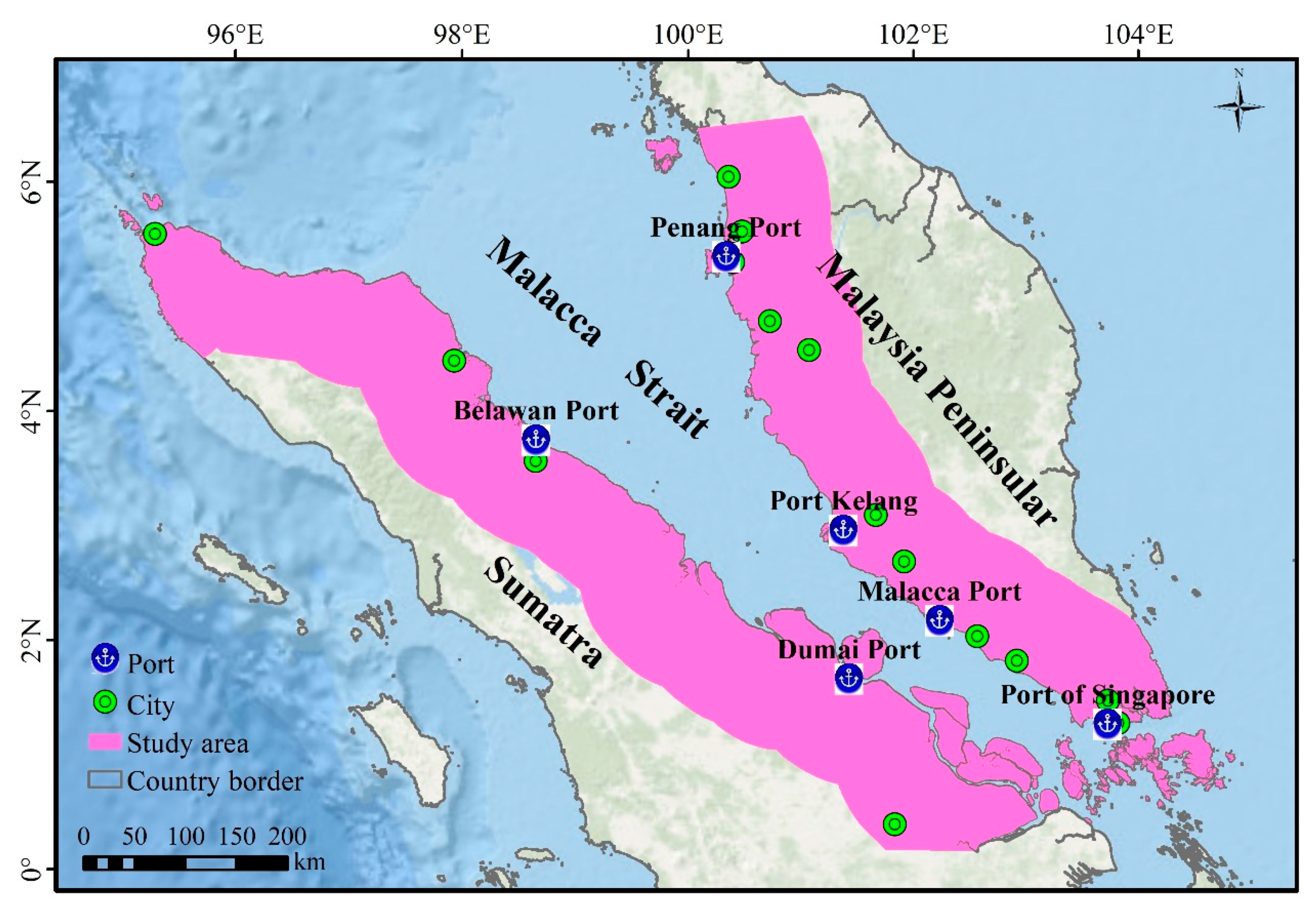
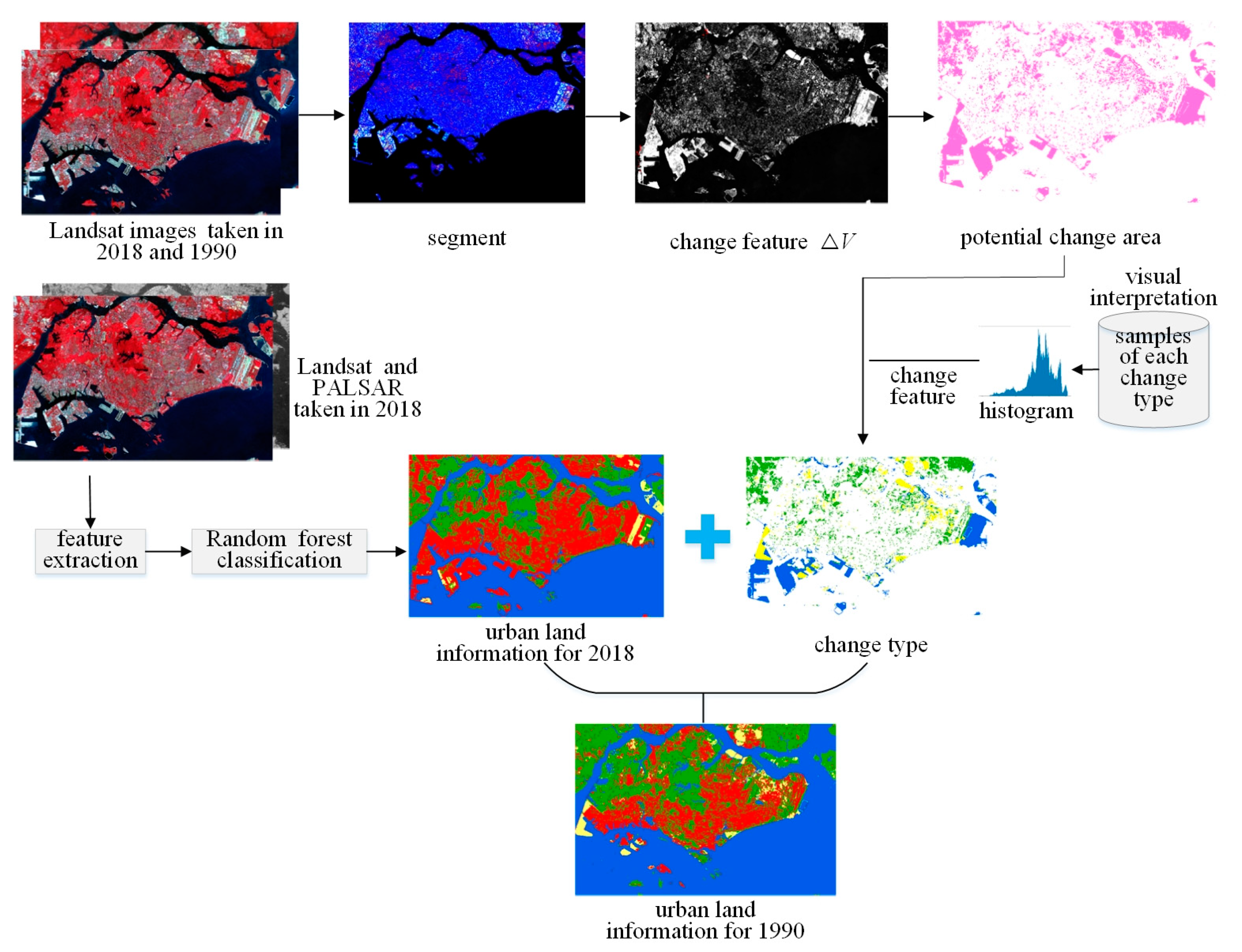
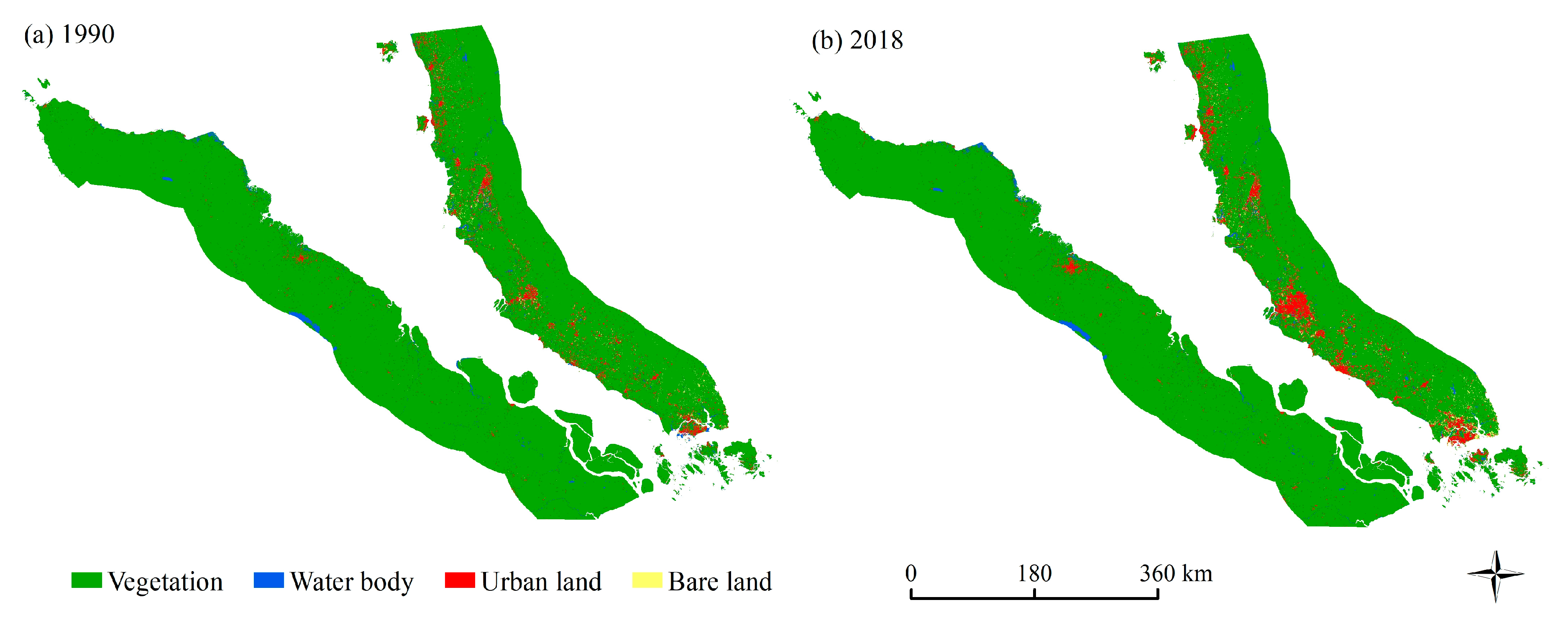
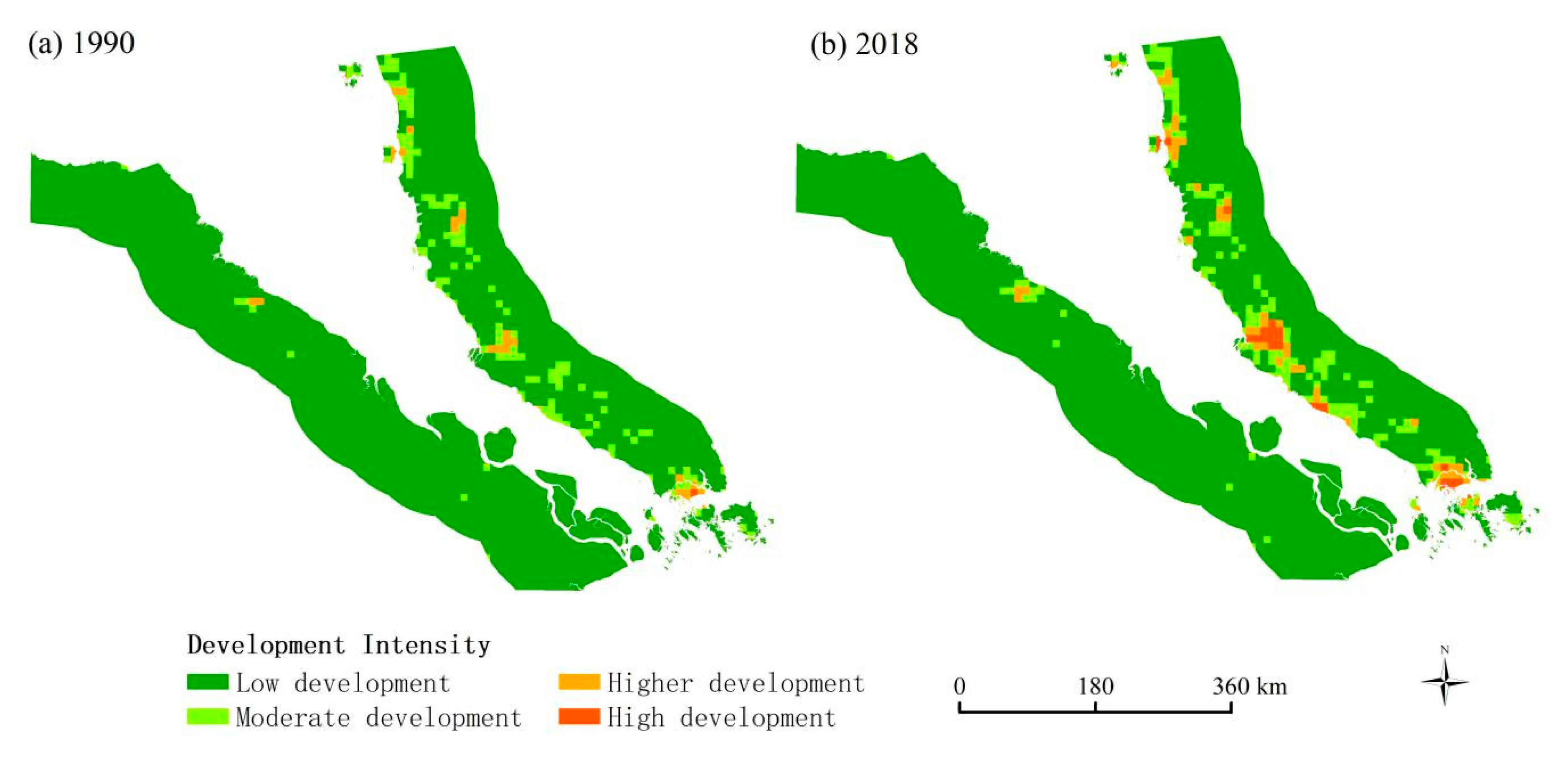

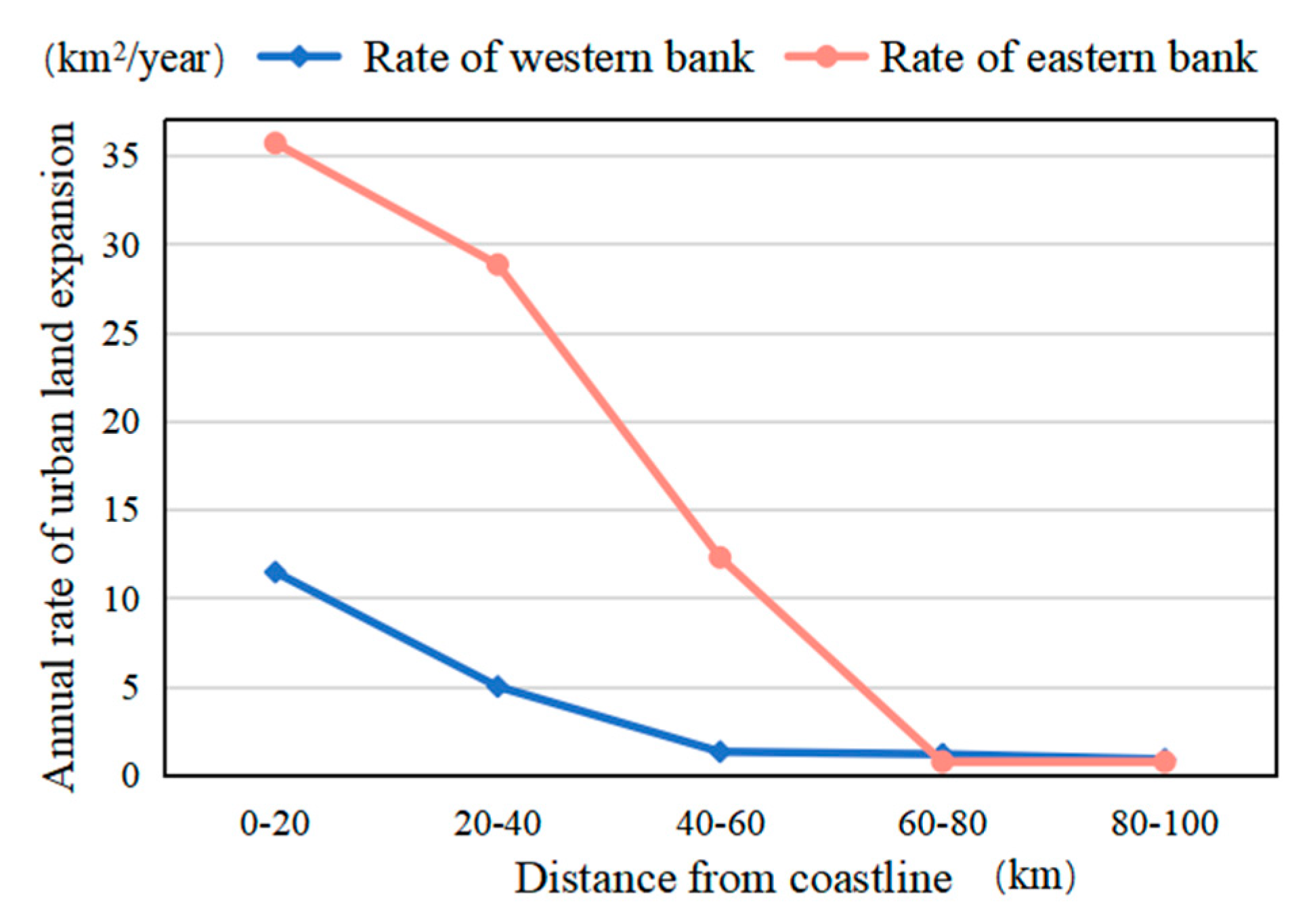
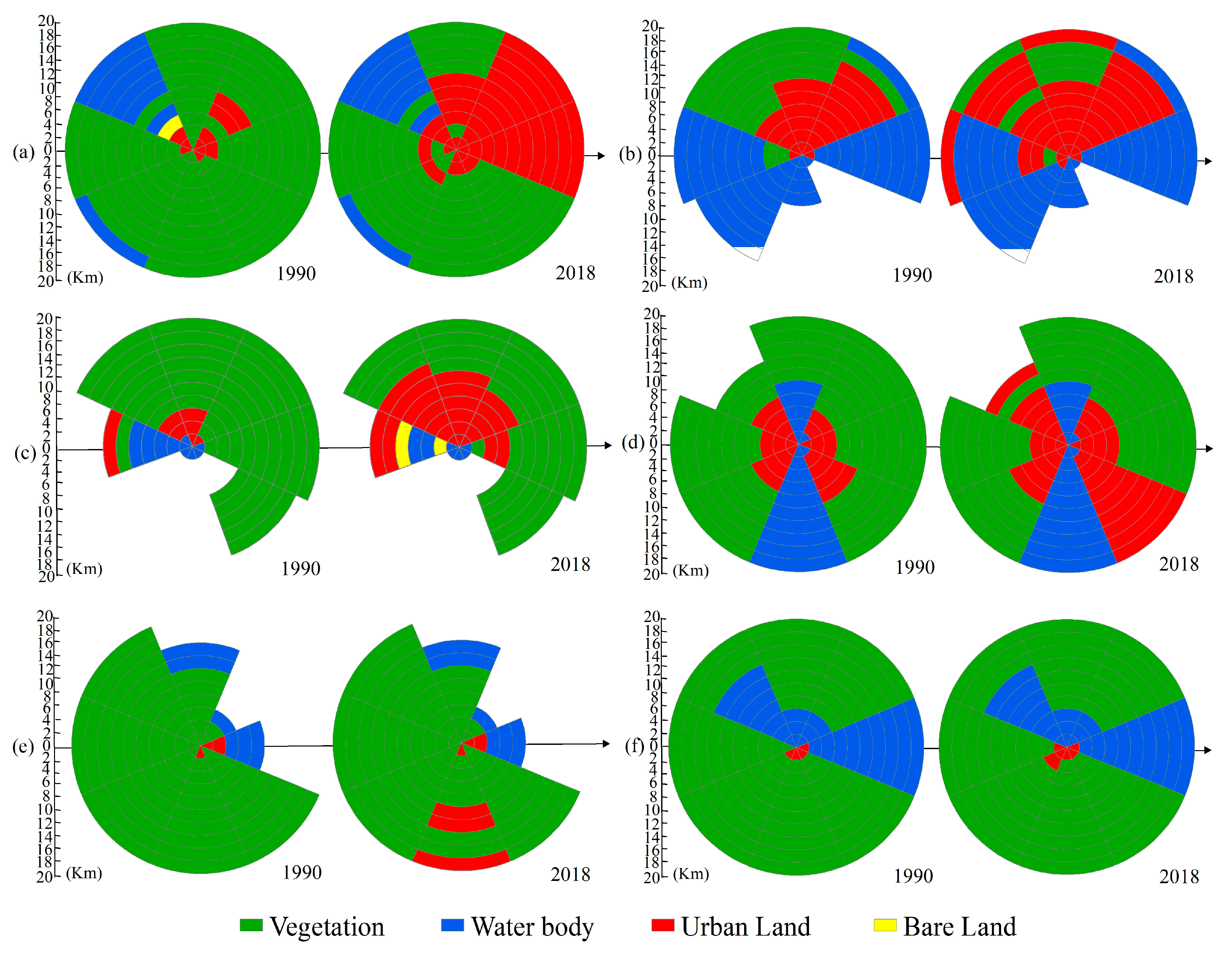
| Transformation Type | Rules |
|---|---|
| Vegetation | dNDVI< 0 and NDBI1990 < 0 and MNDWI1990 < 0 |
| Water body | dMNDWI < 0 and MNDWI1990 > 0 and rectangle fit < 1 |
| Bare land | dNDBI < 0 and NDBI1990 > 0 and NDVI1990 < 0.2 |
| Urban land | dNDBI < 0 and dNDVI > 0 and NDVI1990 < 0 and MNDWI1990 < 0 |
Publisher’s Note: MDPI stays neutral with regard to jurisdictional claims in published maps and institutional affiliations. |
© 2020 by the authors. Licensee MDPI, Basel, Switzerland. This article is an open access article distributed under the terms and conditions of the Creative Commons Attribution (CC BY) license (http://creativecommons.org/licenses/by/4.0/).
Share and Cite
Yang, F.; Yang, X.; Wang, Z.; Liu, Y.; Liu, B. Changes and Regional Differences in Urban Land Areas on Both Banks of the Strait of Malacca Based on Remote Sensing. Sustainability 2020, 12, 9714. https://doi.org/10.3390/su12229714
Yang F, Yang X, Wang Z, Liu Y, Liu B. Changes and Regional Differences in Urban Land Areas on Both Banks of the Strait of Malacca Based on Remote Sensing. Sustainability. 2020; 12(22):9714. https://doi.org/10.3390/su12229714
Chicago/Turabian StyleYang, Fengshuo, Xiaomei Yang, Zhihua Wang, Yueming Liu, and Bin Liu. 2020. "Changes and Regional Differences in Urban Land Areas on Both Banks of the Strait of Malacca Based on Remote Sensing" Sustainability 12, no. 22: 9714. https://doi.org/10.3390/su12229714







